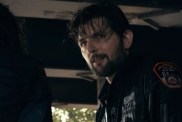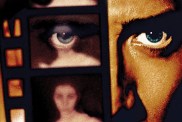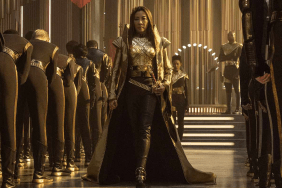“Are you ready?”
That’s what it says on a small plaque at the front door of J.J. Abrams’ Santa Monica-based Bad Robot Productions. The building, deceptively ordinary from the outside, feels from the inside as though it’s equal parts office, workshop and top secret military compound. This week, ComingSoon.net was among the first members of the press ever invited inside to take an early look at next summer’s Star Trek Into Darkness.
Abrams himself began the presentation with a look at a new extended trailer that will be online December 17th. The primary difference between it and the first trailer (along with a few extra shots) is a voiceover by Bruce Greenwood’s Admiral Pike. He tells Chris Pine’s Captain Kirk that Kirk is just too reckless and that, one day, his actions are going to get him and his entire crew killed. There’s also a rather intriguing shot of what appears to Zachary Quinto’s Spock leaping from the top of a city skyscraper.
After leaving the screening room, our group moved on to first speak with David Leroy Anderson, a nearly 30-year veteran of cinematic makeup effects. At first, Anderson didn’t think that he would be getting quite as hands-on for Star Trek Into Darkness as he did. It was Quinto who convinced him that his specific skill was needed to apply the actor’s makeup which, for the part of Spock, involved first shaving off half of each eyebrow and then painstakingly sewing on individual hairs every morning while another artist applied Quinto’s Vulcan ears. For this film, there are no shortcuts.
“IMAX,” Anderson jovially groaned about the ultra-detailed format. “High def. You see everything.”
One of Anderson’s big challenges this time around was the alien creatures that live on the planet Nibiru. The primitive, pre-warp civilization can be seen in the first nine minutes of the film (which fans can check out before select IMAX theaters this weekend.)
Working backwards from an actor with a very distinct head shape, Anderson created prosthetics for a pale, black-eyed humanoid form and fellow tribe members that are covered in what looks like white mud and black painted markings. There was initial discussion about making the people of Nibiru two distinct sexes, but it was ultimately decided that male and female members of the species would be more or less interchangeable to the human eye. There is, however, a baby that Anderson also designed as a hand-puppet that can be operated by the actor holding it.
In the beginning of the film, Kirk and Karl Urban’s Dr. McCoy have infiltrated the Nibiru society to stop a volcano from erupting. Because of the Prime Directive, they can’t reveal themselves and wear full body robes. Originally, Anderson was going to have them actually disguised as Nibiru with plastic surgery (as in the original series episode “The Enterprise Incident”), but Abrams thought it might get too confusing, especially if audiences were to think that McCoy performed the surgery on himself.
Anderson was also tasked with designing makeup for Klingons, which make their official debut in the sequel (scenes were shot for Abrams’ original Star Trek, but were ultimately deleted from the film. Even there, though, the Klingons were shown under metal masks.)
“There’s only two that remove their helmets,” Anderson said of the Into Darkness Klingons. “There’s 14 of them in all, but 12 of them keep their helmets on.”
Because Klingons in the original series look so different from the way the race is depicted in Star Trek: The Motion Picture on, Anderson went about creating a look that homages both. The two speaking Klingons have forehead ridges, but they’re decorated with ornamental piercings and their facial hair is a bit more in keeping with the original show.
“It was a real debate if we should put the long hair on the two that pull their hats off,” he said, “but it was J.J.’s choice not to.”
Most mysterious of the aliens showcased was GAT-5000, a human (or, at least, human-looking) individual with a surgical implant in the top of his head.
“Digitally, we put a bunch of designs in there,” Anderson explained. “Really mechanical-looking things. Busy things. We did a couple of tests with different circuitry around it. In the end, I laid down on the floor on the bridge and I took a picture of the light overhead, which no one will ever see on the bridge. It’s this beautiful light and that’s what I put in there.”
Moving on from makeup, our group was led into a small editing bay where composer Michael Giaccino spoke a bit about his work on the score, explaining that, at this stage, all the work he’s done is in those first nine minutes. His creative approach has meant that he still hasn’t read the script or seen anything beyond that opening scene and won’t until he tackles a near-finished version of the film in January.
“The first thing I figure out is what the tempo of a particular scene should be,” saids Giaccino. “For that, I can watch it and just get a sense of what that is. I’ll watch it and I’m usually tapping the tempo. Then I ask if everything’s hitting. Do the shots cut at a certain place? Am I hitting it right on the beat? I try to find that perfect tempo Music doesn’t alway say what’s coming out of their mouths. Music says what’s going on inside their hearts.”
Although he writes the music all by himself, it’s the work of a 100 person orchestra that brings the score to life.
“The players that I get to work with are among the finest in the entire world,” Giaccino continued. “They come to the stage that day having no idea what they’re about to play. No idea the style of music or anything. I can put anything in front of them. Anything. They will play it through the first time. That’s how good they are… It’s because of them that these films can have the emotional core that they have.”

Even though “Star Trek” has a rich history of iconic scores, Giaccino think that it’s important to step back and offer something original.
“You want to pick your moments to pay homage to what came before,” he said. “For me on the last film it was waiting until they end credits when they were all on the bridge of the Enterprise when they were together as a crew. That, to me, felt like ‘Star Trek’ and I wanted to use Alexander Courage’s theme. You have to be careful using too many lifts from other stuff because then you’re watering down your idea of what ‘Star Trek’ is or what this film is.”
Although the bulk of the first nine minutes shows off a classic “Star Trek”-style adventure, the very opening follows the lives of Noel Clarke and Kayla Hassan’s characters as they visit their dying daughter in a 23rd century hospital.
“The idea with the opening at the hospital was to give a sense of, ‘Wait, is this ‘Star Trek’?” Giaccino continued. “‘Am I in the wrong theater? What is this?’ I don’t want to use the word ‘misdirect,’ but we wanted to keep the audience sort of distant from the emotion of it. You’re in a hospital so it can get very sappy very quickly and we didn’t want that. The idea is that there’s something else going on here and you’re not sure what it is yet. It’s evolving and growing behind the scenes of whatever is playing out before us.”
Moving into another editing Bay, Visual Effects Supervisor Roger Guyett showed off the complex work that is going into creating the world of Into Darkness.
“Obviously, our job was to build a more exciting movie than what we saw last time,” he announced, “and build on the ideas that we had in that movie… At the heart of that is the story.”
The sequel isn’t just bigger than the first film in terms of effect shots (there are more than 1,400 this time around). Into Darkness also has the added challenge of 3D and IMAX and, even with computer speed moving forward exponentially, some scenes in the final film (such as the Enterprise rising out of the ocean of Nibiru) can take weeks to render.
“We’ve probably got somewhere between 30 and 40 minutes of the final movie that’s going to be in the IMAX format,” Guyett said. “A substantial piece of the movie is going to be on that very large scale.”
Two of the big focuses for Guyett this time around are the future versions of both San Francisco and London, both of which play a large role in Into Darkness‘ plot.
“We tried to really respect the cultural aspect of our version of futurism,” he says. “We were thinking, ‘If you were in London, how would that city expand? How would people use the space they’re in? What kind of buildings would people design and how would they fit into the general landscape?’ We try to be realistic in how we think people are going to live. It’s not a strange version of the future. It’s a relatively accessible one.”
Because Abrams is a fan of natural light, as much as possible of Into Darkness was filmed on practical sets. Guyett showed off footage of Spock both in the volcano and leaping off the skyscraper to demonstrate how an actual actor can then be digitally added to a bigger-than-life environment.
Winding down the presentation, Prop Master Andy Siegel and Asst. Costume Designer Ann Foley offered up a look at many of the practical items used for film. That’s where Foley broke the news that one of the grey Navy-style dress uniforms belongs to Alice Eve’s Carol Marcus, a character known for her appearance in Star Trek II: The Wrath of Khan and for being the mother of Kirk’s son, David.
As far as plot details, it was also revealed that the “civilian” outfits that the crew are seen wearing in the trailer are from a sequence on Qo’noS, the Klingon homeworld.
“Trek” fans will no doubt notice the similarities between the film’s new Starfleet wetsuits and the costumes from “Star Trek: Enterprise.” Similar in color, the suits have the same colored lines on either shoulder to signify yellow for command, blue for science and medical or red for engineering and security. Uhura’s wetsuit is a bit different, however, reversing the scheme and giving her a primarily red outfit.
Also present was Spock’s protective volcano suit, covered in metal tiles and weighing over 60 pounds.
“He’s going into an active volcano,” Foley explained, “so we wanted something that looked like it could protect him. J.J. loved the idea of seeing the flames reflected off of his suit and off of his visor… It’s really beautiful how it works.”
Other information, however, the pair remained completely mum about. When asked if a silver cane with the Starfleet logo at the top belonged to Pike (who was seen in a wheelchair at the end of the 2009 film), Siegel only smiled.
“That is a cane,” he grinned.
The full story behind that prop, it seems, will just have to wait until next summer when Star Trek Into Darkness hits theaters everywhere. In the words of Bad Robot, “Are you ready?”









